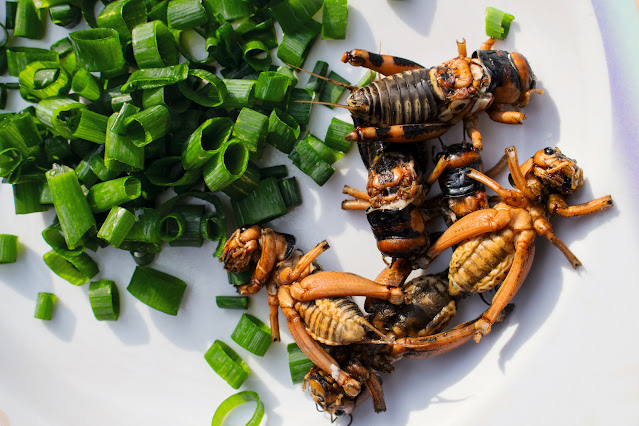Edible Insects are consumed in a wide range of Cultures as they provide essential Nutrients and Amino Acids.
 |
| Edible Insects |
Insects are frequently seen as a nuisance to humans and
pests to crops and animals. However, this is not the case. Insects produce food
at a minimal environmental cost, contribute to human well-being, and play an
important role in nature. However, the general public is usually unaware of
these advantages. Insects, contrary to common assumption, are not just
"famine foods" used during times of food shortage or when purchasing
and gathering "traditional foods" becomes problematic; many people
across the world eat insects because they are tasty and have a long history in
local culinary cultures.
Because of the rising expense of animal protein, food and
feed insecurity, environmental concerns, population expansion, and increasing
demand for protein among the middle classes, insects as food and feed have
become a particularly critical topic in the twenty-first century. As a result, alternative
livestock and feed sources must be obtained as soon as possible. As a result,
insect ingestion, also known as entomophagy, benefits the ecosystem, as well as
people's health and livelihoods.
According to Coherent
Market Insights, The global Edible
Insects Market is projected to surpass US$ 850 million by the end of
2027, in terms of revenue, growing at CAGR of 6.7% during the forecast period
(2020 to 2027).
Globally, the most commonly consumed Edible Insects are beetles (Coleoptera) (31 percent), caterpillars
(Lepidoptera) (18 percent) and bees, wasps and ants (Hymenoptera) (14 percent).
Following these are grasshoppers, locusts and crickets (Orthoptera) (13
percent), cicadas, leafhoppers, planthoppers, scale insects and true bugs
(Hemiptera) (10 percent), termites (Isoptera) (3 percent), dragonflies
(Odonata) (3 percent), flies (Diptera) (2 percent) and other orders (5
percent).
Insects are thought to be present in the traditional diets
of at least 2 billion people. More than 1900 species are said to have been
consumed as food. Insects provide a variety of ecological functions that are
critical to humanity's survival. They also serve as pollinators for plant
reproduction, improving soil fertility through waste bioconversion, and
providing natural biocontrol for harmful pest species, as well as providing a
variety of valuable human products such as honey and silk, as well as medical
applications such as maggot therapy. Insects have also found a place in human
societies as collectibles and decorations, as well as in films, visual arts,
and literature.
Some edible bug species are now under jeopardy for the first
time in history. Many Edible Insects
populations have declined due to anthropogenic reasons such as overharvesting,
pollution, wildfire, and habitat deterioration. Climate change will very
certainly influence the distribution and availability of edible insects in
unforeseen ways.
Edible insects
may be found in a wide range of environments, including aquatic ecosystems,
agricultural land, and woodlands. Insects were once thought to be an infinite
resource that could be harvested from nature. How The high feed conversion
efficiency of insects underpins the environmental benefits of keeping insects
for food and feed. For every 1 kilogramme of bodyweight growth, crickets, for
example, require just 2 kg of feed. Insects can also be raised on organic waste
streams (such as human and animal waste) to help minimise pollution in the
environment. Insects are said to produce fewer greenhouse gases and ammonia
than cattle or pigs, as well as requiring substantially less land and water.
Efforts like this help to promote habitat conservation.
Edible Insects are
a high-fat, high-protein, high-vitamin, high-fiber, and high-mineral-content
dietary source. Because of the enormous variety of edible bug species, the
nutritional value of edible insects varies greatly. Even within the same
species, nutritional value varies depending on the insect's metamorphic stage,
environment, and food. Mealworms, for example, have a similar composition of
unsaturated omega-3 and omega-6 fatty acids to fish (and higher than cattle and
pigs), and their protein, vitamin, and mineral content is equivalent to fish
and meat.



Comments
Post a Comment